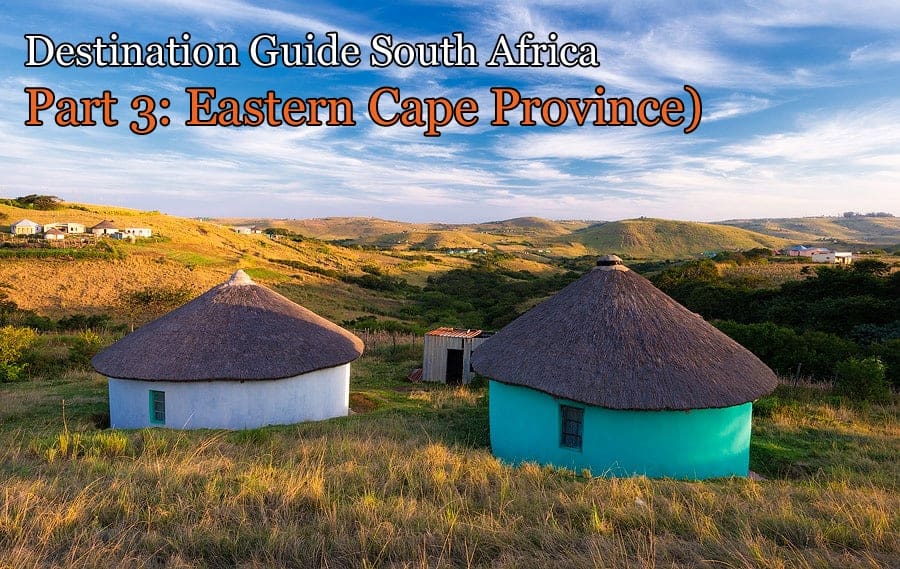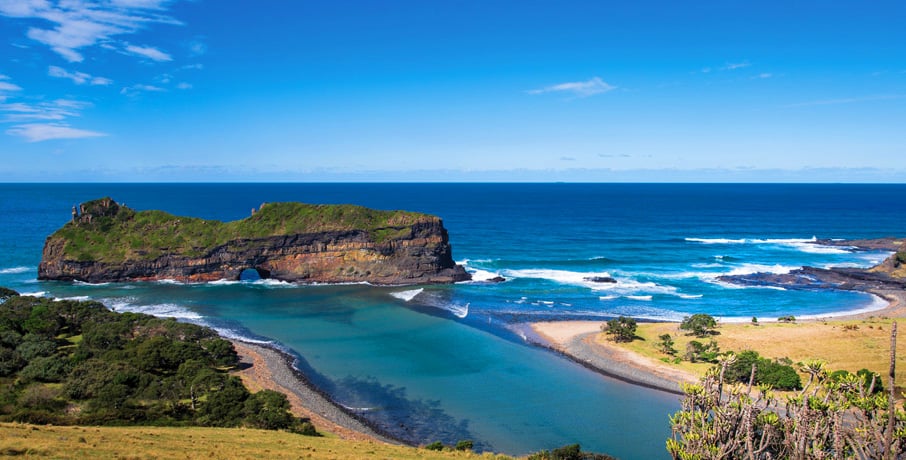
Travel Guide to Eastern Cape Province
Eastern Cape Province (and the Transkei)
The Eastern Cape stretches from its SW border at Bloukrans River, stretching along the coast as far as Kokstad (inland) and Port Edward (Umtamvuna River) on the Kwa-Zulu Natal border in the north – a distance of almost 1.000 kms. This huge province includes the traditional homeland of the Xhosa, the 2nd largest tribe in South Africa, called the Transkei. Outside of its two major cities – Port Elizabeth and East London – and a relatively few small country towns – Grahamstown, Queenstown or Port Alfred – it is as overwhelmingly rural and agricultural region.
The Bloukrans / Storm River areas of the province have already been covered in the Garden Route section. Arriving from the Cape and the Garden Route on the N-2, many visitors will stop off at Jeffreys Bay – a resort town dedicated to and given over entirely to surfing….and a variety of other water and breaker sports. The coast along Jeffreys Bay, and Cape St-Francis, near the upscale, thatched-roof community of St Francis Bay, is world-famous for its year-round surfing conditions. Ever since the 1967 film “Endless Summer” first made the area famous it’s been a Mecca for surfers.

Above: Port Elizabeth
From there, it’s a short 70 kms drive northwards to Port Elizabeth, a major port , industrial centre and hub of the country’s automotive, tyre and car-parts manufacturers. Known as the “Windy” (or “Friendly”) City – take your pick – it’s usually of limited interest for most visitors. But it provides a good selection of attractions which make for a worthwhile stopover. http://www.nelsonmandelabay.gov.za/Content.aspx?objID=205
The city has a terrific architectural heritage of Victorian colonial homes and buildings dating back to its founding by the English settlement of the country in 1820. The ‘ Heritage Trail’ in the city centre covers major attractions – the Donkin Reserve, Terrace Houses, the nearby Horse Memorial (to the horses killed in the Boer War, and evidently the only monument in the world to our equine friends), the restored Wool Exchange (a major centre for the merino wool market), old Feather Exchange building (ostrich feather market), Public Library, City Hall and Portuguese (Prestor John) memorial. The 52 meter high Campanile, built in 1923 to commemorate the Settlers’ arrival, and the city’s landmark provides an excellent panorama over the centre, the port as well as nearby beaches.
The Boardwalk Casino and Entertainment World in Summerstrand offers gaming and a variety of entertainment, shopping and restaurant options, and all, just across the road from some of the city’s best beaches – Hobie and Summerstrand.
But the major attraction of the area, 70 kms north of the city, is the now much expanded Addo Elephant National Park, home to the most southerly elephant herds on the continent. Due to its endemic ‘elephant food’ bushes, the reserve supports a very high density of elephants and a wide variety of other South African game too. The NP provides a full range of accommodations, shops and restaurants. If you are not visiting any other National Parks further north make sure to visit Addo. In fact make sure you do anyway! Be sure to check out : http://www.sanparks.org/parks/addo/ . Addo is also home to several private game-reserves offering luxury accommodations, game-viewing and ‘ services’ as those further north in Mpumalanga, KwaZulu-Natal etc – all in a malaria-free environment. The most renowned is Shamwari, amongst others. http://www.shamwari.com/propertydefault.asp?MicroSiteID=2
Grahamstown, the 1820 ‘frontier’ city of the English settlers lies 130 kms up the inland N-2 road from Port Elizabeth, and is the half-way point to East London. The town is a major educational centre, having several of the finest schools in the country as well as Rhodes University – the smallest (and best ?) in the nation. The town makes for a great stopover – for its architecture, beautiful if ‘oversized’ Cathedral (and 40 plus other churches), Botanical Garden and not least, the fascinating Observatory Museum which includes the only Camera Obscura in the southern Hemisphere. The town, at the centre of ‘pineapple’ country’, makes a convenient base for the nearby Sunshine Coast resorts (Port Alfred, Bushmans River etc) and many excellent, ‘off-the-track’ game reserves in the region, like Kandwe or Kichaka. http://www.grahamstown.co.za/page/grahamstown
East London (“Buffalo City”) is an attractive city, and with its sub-tropical climate and vast beaches, is a popular resort town – as well as a major port (South Africa’s only river port). It makes for a pleasant base from which to explore the Sunshine Coast to the south (where the German immigrants first settled), the inland Ciskei country and Amatola Mountains. The city is the southern gateway to the Transkei , lying just across the Kei River not far to the north. For a lot more, see : http://www.eastlondon.org.za/ and http://www.safarinow.com/things-to-do/east-london/default.aspx
Alternative Port Elizabeth – East London Route: The main 300 kms N-2 road (above) from Port Elizabeth to East London follows an inland route away from the coast. An alternative, slower route is the N-72 , which leaves the N-2 about 30 kms out of PE, following the coast through several small Sunshine Coast communities – Bushmans’ River, Port Alfred, Great Fish River Mouth, Hamburg and Kidds Beach – to East London. This road crosses rolling hills of coastal bush and pineapple farms. A stop off at any of the beaches along the route means magnificent surfing, sand-surfing , swimming and hiking opportunities on deserted sands. Although there are several longer hiking trails (2 to 5 day circuits) in the area my suggestion would be to take such hikes in the more dramatic, rugged and interesting Garden Route or Wild Coast areas. It is important to note that this route is a country road, through often unfenced land – so watch out for roaming animals – as well as ‘potholes’ ! http://www.sunshinecoasttourism.co.za/home.htm
The 450 kms route from East London through the Transkei to the KwaZulu-Natal (KZN) border crosses the ‘homeland’ of the Xhosa tribe; a green, rural, communal (unfenced) agricultural land of beautiful rolling – often eroded – hills, and villages. The road follows an inland route down the middle of one of the most traditional, but poorest and undeveloped regions of the country. The main N-2 road is always thronged with traffic, people and roaming animals. The towns along the N-2 are poor and scruffy, holding little interest for the visitor – Umtata (now Mthatha), the ‘capital’ and largest town being a possible exception. The Drakenberg mountains form the inland border – and barrier – with Lesotho; the oceanside ‘border’ being the Indian Ocean – and the rugged “Wild Coast” . Unfortunately, there is no coastal road through the Transkei – the Wild Coast being exactly that – too wild and rugged for any road. The coast, and its beaches, villages and attractions with their balmy sub-tropical climate, can only be reached by side roads (often gravel) from the N-2 , which can be as much as 100 kms from the coast. Before heading to the coast be sure to stock up with all the provisions you need – everything possible, including petrol and water! Often you can end up a few hours or more drive from the nearest supplies. Be prepared for some slow, arduous – but incredibly beautiful and interesting driving down to the coast. http://www.footprinttravelguides.com/africa-middle-east/south-africa/eastern-cape/wild-coast/
Below: Hole in the Wall, near Coffee Bay
Here, it is the Wild Coast itself that is the main attraction … and what a coast it is ! But it can be difficult to get to unless you have your own wheels … the long distance buses stick to the main inland road – even Baz Bus . However, most hotels on the coast – as well as many backpacker hostels , at least in Port St Johns, Mpande and Coffee Bay – provide, or can arrange a shuttle to meet the bus (intercity or otherwise) in Mthatha at supplementary cost. There is NO mass-tourism here! The small coastal ‘villages’ are often not much more than a few ‘rondhavel’ huts but in season, they are fully booked anyway. The entire “Wild Coast’ very much remains totally “off the beaten path” … But it offers a selection of activities and attractions, centered on beach, surfing and water sports, quad trails, paragliding and biking. However, it is the hiking and horse-trekking in the area that is phenomenal …and it is the only way to get from one coastal point to another , without heading back inland and then down to the coast again. http://www.havenhotel.co.za/index.php/things-to-do http://www.mkulukeihorsetrails.co.za/wildphotos.htm
From south to north, some suggestions for coastal points : — Kei Mouth ; — Mazeppa Bay ;— The Haven (and Divesa Nature Reserve); — Coffee Bay and “Hole -in-the-Wall” (just south of Coffee Bay); — wild , wacky, weird Port-St-Johns (the largest coastal town – ); — Port Edward (on the KZN border – and from where there is a coastal road to Durban) Check out :- http://www.active-escapes.co.za/destination/wildcoast/wildcoast.html
For backpackers, there are several hostels in some (but not all) of the coastal communities. See: http://www.alternativeroute.net/backpacker-hostels/wild-coast.html. Transport can be more of a problem. Hostels in PSJ, Mpande and Coffee Bay regularly provide shuttle service from Mthattha upon reservation: elsewhere check with your hostel ahead of time to see if shuttle service is available – and reserve it , if it is! Any / all shuttle service will be at a supplementary cost.
The Transkei, its culture and traditions, are one of the touchstones of South Africa itself. If you have the time, interest, or inclination, it’s possible to see and learn of the great many tribal rituals governing Life at first hand. Some – beer brewing, courting, dancing etc are worth experiencing; others, like birth, initiation/circumcision, illness/medicine, marriage or funeral customs , perhaps not! A unique 5-day ‘cultural’ hike, from Port-St-Johns to Coffee Bay, totally immersed in Xhosa culture is available, and can be found at : http://www.wildcoasthikes.com/ Find out more on Xhosa culture and traditions at: http://kwekudee-tripdownmemorylane.blogspot.ca/2013/02/xhosa-peoplesouth-africas-ancient.html or at http://www.ezakwantu.com/Gallery%20Lister%20Hunter%20Photo%20Set%20G%20-%20Xhosa%20Tribes.htm
THE TOP TOURS TO EXPERIENCE IN EASTERN CAPE PROVINCE
Back to main South Africa page (the above is Part 3 of 6)


Leave a Reply